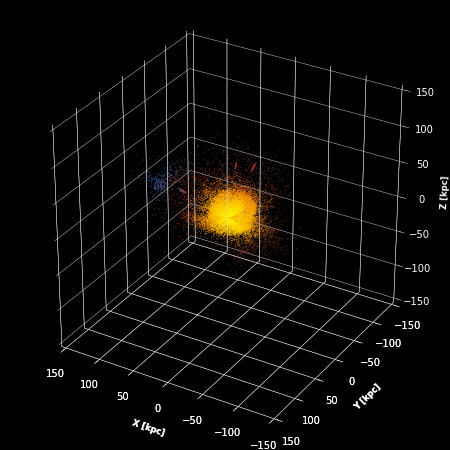How does our Milky Way look like?
classifying variable sources
Catalogs of RR Lyrae stars can help using them as tracers for uncovering Galactic substructure to beyond the Milky Way tidal radius at ~300 kpc and revealing details of satellite galaxies.
Using RR Lyrae periods and metallicities allows for a precise measurement of distances. Also, it makes the search for halo streams and dwarf satellite galaxies possible, constraining galaxy formation and evolution models and also providing data for mapping the Galactic potential.
In further applications, e.g. to reconstruct the history of the Milky Way, identified stars can be used as tracers for underlying stellar populations, for what one need not only to be able to distinguish them from other types of variable sources by a classifier, but also to determine further properties like period and detailed shape of lightcurve. For computational efficiency, it is important to apply both a fast and efficient pre-selection and classification, and determine further properties on carefully pre-selected candidates.
In order to identify and classify variable sources in the Pan-STARRS1 3π survey, we (Nina Hernitschek, Branimir Sesar, Hans-Walter Rix) made use of an astostatistical approach that uses newly derived modeling as well as machine-learning classification.
In area and depth, the Pan-STARRS1 (PS1) 3π survey is unique among many-epoch, multi-band surveys and has enormous potential for all-sky identification of variable sources.
The caveat of this survey, when carrying out signal processing methods for time-domain behavior of astrophysical sources, is that PS1 3π has observed the sky typically only seven times in each of its five bands (grizy) over 3.5 years. This makes the classification of variable sources, and moreover the task of assigning precise periods in the case of stars like RR Lyrae an Cepheids extremely challenging. I developed a new approach for quantifying statistical properties of non-simultaneous, sparse, multi-color lightcurves through multi-band light-curve structure functions. We use this approach to estimate variability amplitudes and timescales for all point-sources brighter than rP1=21.5 mag in the survey. Relying on cross-matched sources on SDSS Stripe 82 as "ground truth", we use a Random Forest Classifier (RFC) to identify QSOs and RR Lyrae based on their variability and their mean PS1 and WISE colors. Aside from the Galactic plane, QSO and RR Lyrae samples of 75% purity and 92% completeness can be selected. On this basis we have identified a sample of ~1,000,000 QSO candidates, as well as an unprecedentedly large and deep sample of ~150,000 RR Lyrae candidates with distances from 10 to 130 kpc. We provide a catalog of all likely variable point sources and likely QSOs in PS1, a total of 25.8 × 106 sources [Hernitschek+2016].
In a subsequent work, we improved the classification for RR Lyrae by developing and applying a template fitting technique that uses well-defined and physically motivated multi-band light curves of RR Lyrae stars. Including these periods in the analysis, we again apply a RFC and finally end up with the widest (3/4 of the sky) and deepest (reaching >130 kpc) sample of RR Lyrae stars to date. The PS1 sample of ~45,000 RRab stars is pure (90%), and complete (80% at 80 kpc). It also provides distances precise to 3%, measured with newly derived period-luminosity relations for optical/near-infrared PS1 bands. The following movie shows this sample of ~45,000 RRab stars, where the heliocentric distance is color-coded. Towards the end of the movie, most stars fade out, leaving only the RRab stars related to the Sagittarius stream.

download high-resolution AVI